transmission JEEP COMPASS LATITUDE 2018 Owners Manual
[x] Cancel search | Manufacturer: JEEP, Model Year: 2018, Model line: COMPASS LATITUDE, Model: JEEP COMPASS LATITUDE 2018Pages: 518, PDF Size: 4.8 MB
Page 122 of 518
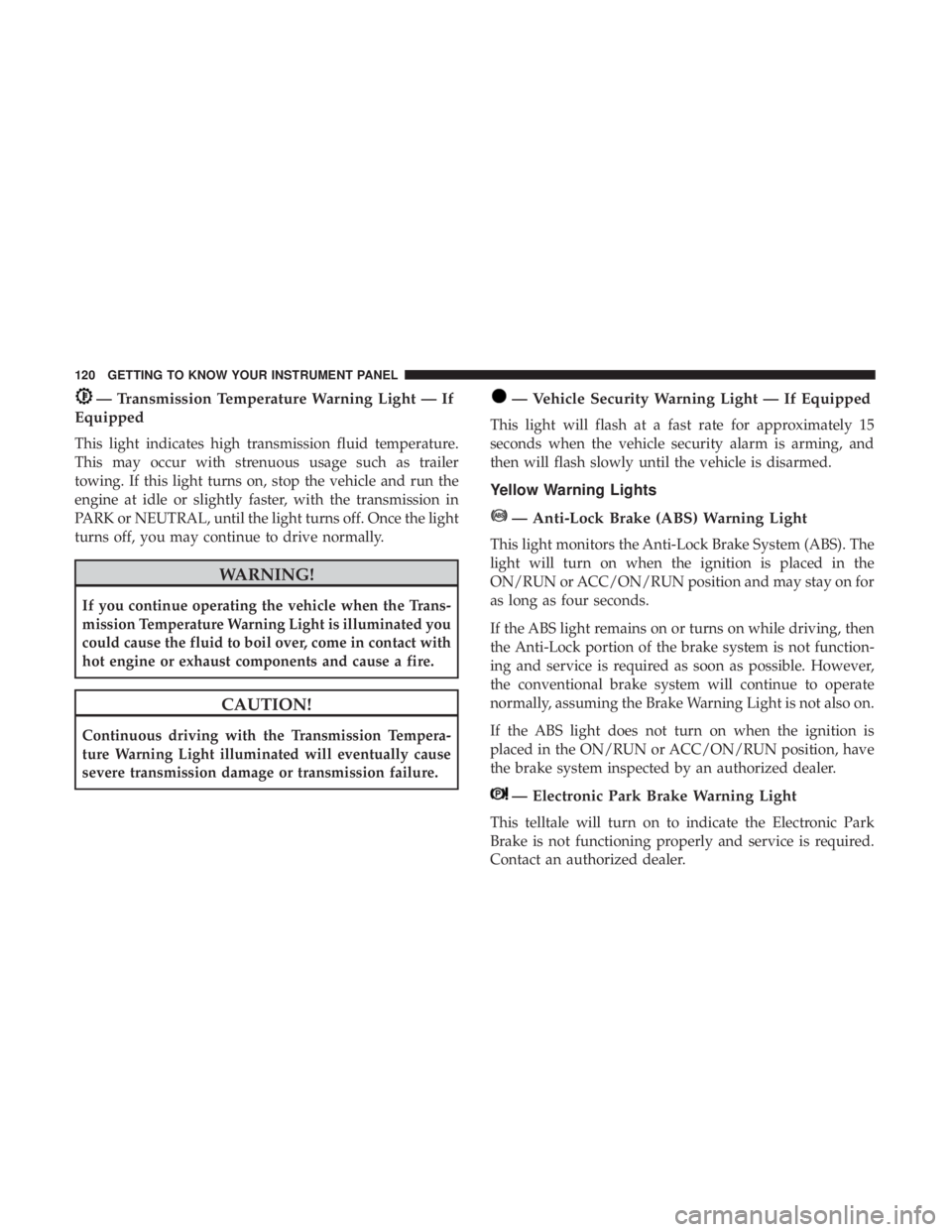
— Transmission Temperature Warning Light — If
Equipped
This light indicates high transmission fluid temperature.
This may occur with strenuous usage such as trailer
towing. If this light turns on, stop the vehicle and run the
engine at idle or slightly faster, with the transmission in
PARK or NEUTRAL, until the light turns off. Once the light
turns off, you may continue to drive normally.
Page 146 of 518

Hill Start Assist (HSA)
The HSA system is designed to mitigate roll back from a
complete stop while on an incline. If the driver releases the
brake while stopped on an incline, HSA will continue to
hold the brake pressure for a short period. If the driver
does not apply the throttle before this time expires, the
system will release brake pressure and the vehicle will roll
down the hill as normal.
The following conditions must be met in order for HSA to
activate:
•The feature must be enabled.
• The vehicle must be stopped.
• Park brake must be off.
• Driver door must be closed.
• The vehicle must be on a sufficient grade.
• The gear selection must match vehicle uphill direction
(i.e., vehicle facing uphill is in forward gear; vehicle
backing uphill is in REVERSE gear). •
HSA will work in REVERSE gear and all forward gears.
The system will not activate if the transmission is in
PARK or NEUTRAL. For vehicles equipped with a
manual transmission, if the clutch is pressed, HSA will
remain active.
Page 233 of 518
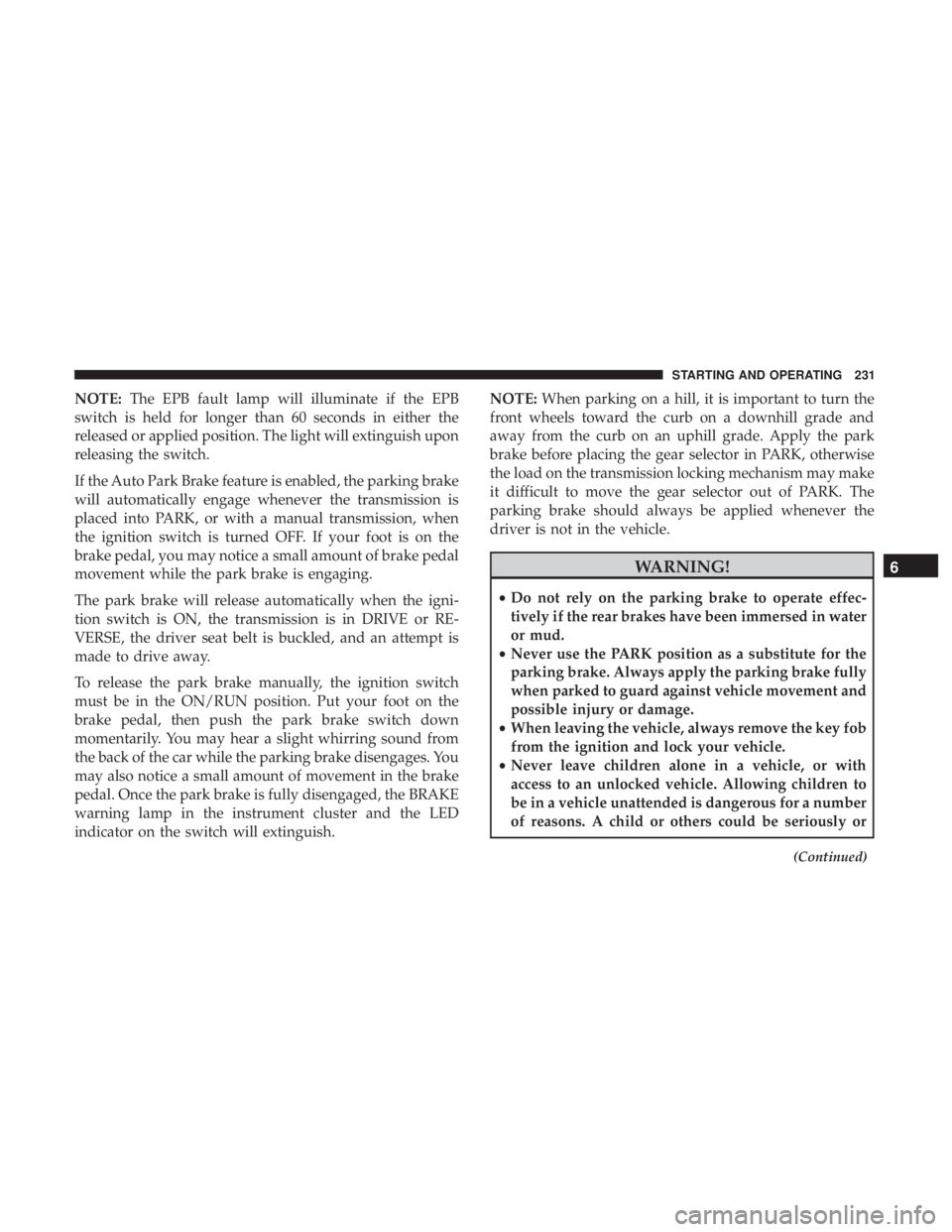
NOTE:The EPB fault lamp will illuminate if the EPB
switch is held for longer than 60 seconds in either the
released or applied position. The light will extinguish upon
releasing the switch.
If the Auto Park Brake feature is enabled, the parking brake
will automatically engage whenever the transmission is
placed into PARK, or with a manual transmission, when
the ignition switch is turned OFF. If your foot is on the
brake pedal, you may notice a small amount of brake pedal
movement while the park brake is engaging.
The park brake will release automatically when the igni-
tion switch is ON, the transmission is in DRIVE or RE-
VERSE, the driver seat belt is buckled, and an attempt is
made to drive away.
To release the park brake manually, the ignition switch
must be in the ON/RUN position. Put your foot on the
brake pedal, then push the park brake switch down
momentarily. You may hear a slight whirring sound from
the back of the car while the parking brake disengages. You
may also notice a small amount of movement in the brake
pedal. Once the park brake is fully disengaged, the BRAKE
warning lamp in the instrument cluster and the LED
indicator on the switch will extinguish. NOTE:
When parking on a hill, it is important to turn the
front wheels toward the curb on a downhill grade and
away from the curb on an uphill grade. Apply the park
brake before placing the gear selector in PARK, otherwise
the load on the transmission locking mechanism may make
it difficult to move the gear selector out of PARK. The
parking brake should always be applied whenever the
driver is not in the vehicle.
Page 234 of 518
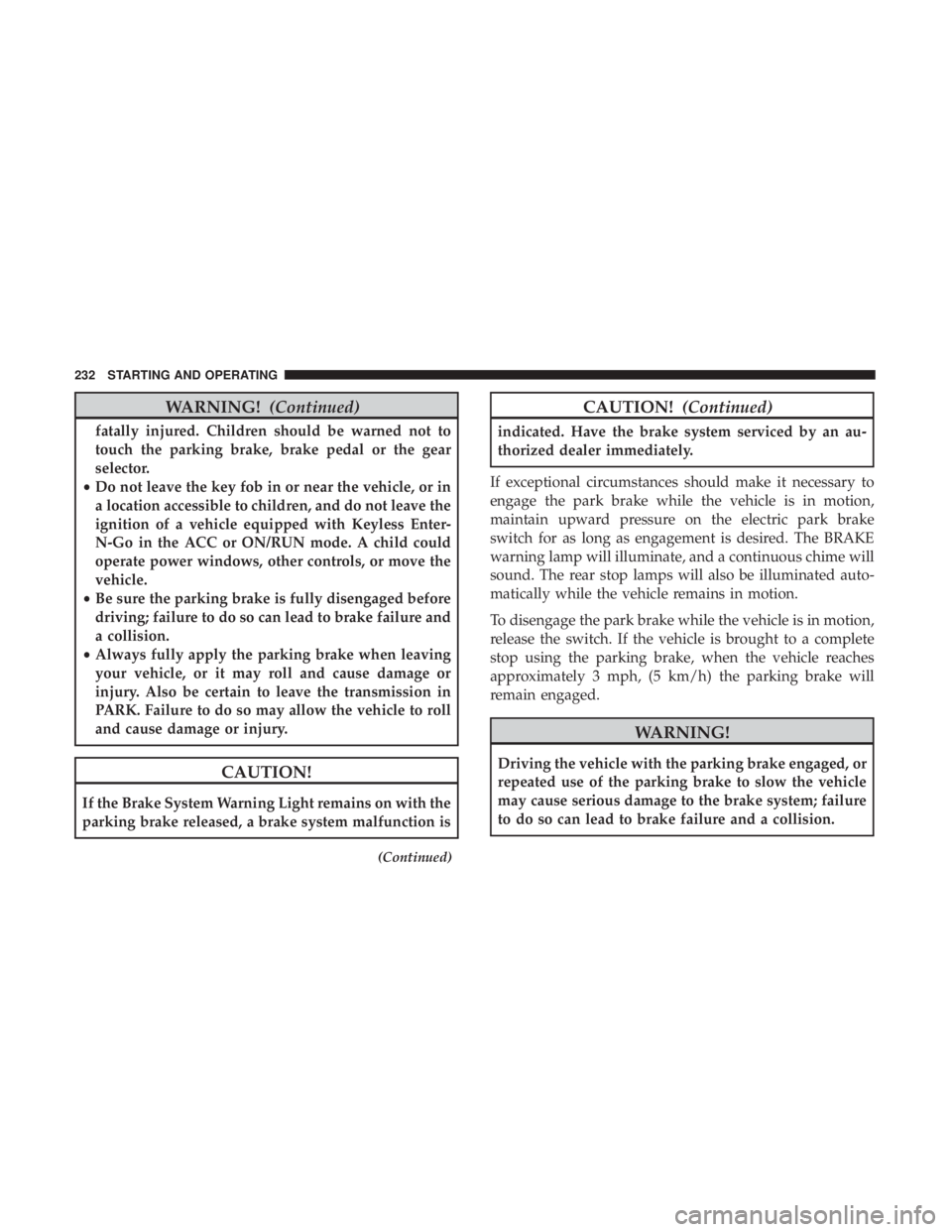
WARNING!(Continued)
fatally injured. Children should be warned not to
touch the parking brake, brake pedal or the gear
selector.
• Do not leave the key fob in or near the vehicle, or in
a location accessible to children, and do not leave the
ignition of a vehicle equipped with Keyless Enter-
N-Go in the ACC or ON/RUN mode. A child could
operate power windows, other controls, or move the
vehicle.
• Be sure the parking brake is fully disengaged before
driving; failure to do so can lead to brake failure and
a collision.
• Always fully apply the parking brake when leaving
your vehicle, or it may roll and cause damage or
injury. Also be certain to leave the transmission in
PARK. Failure to do so may allow the vehicle to roll
and cause damage or injury.
Page 236 of 518
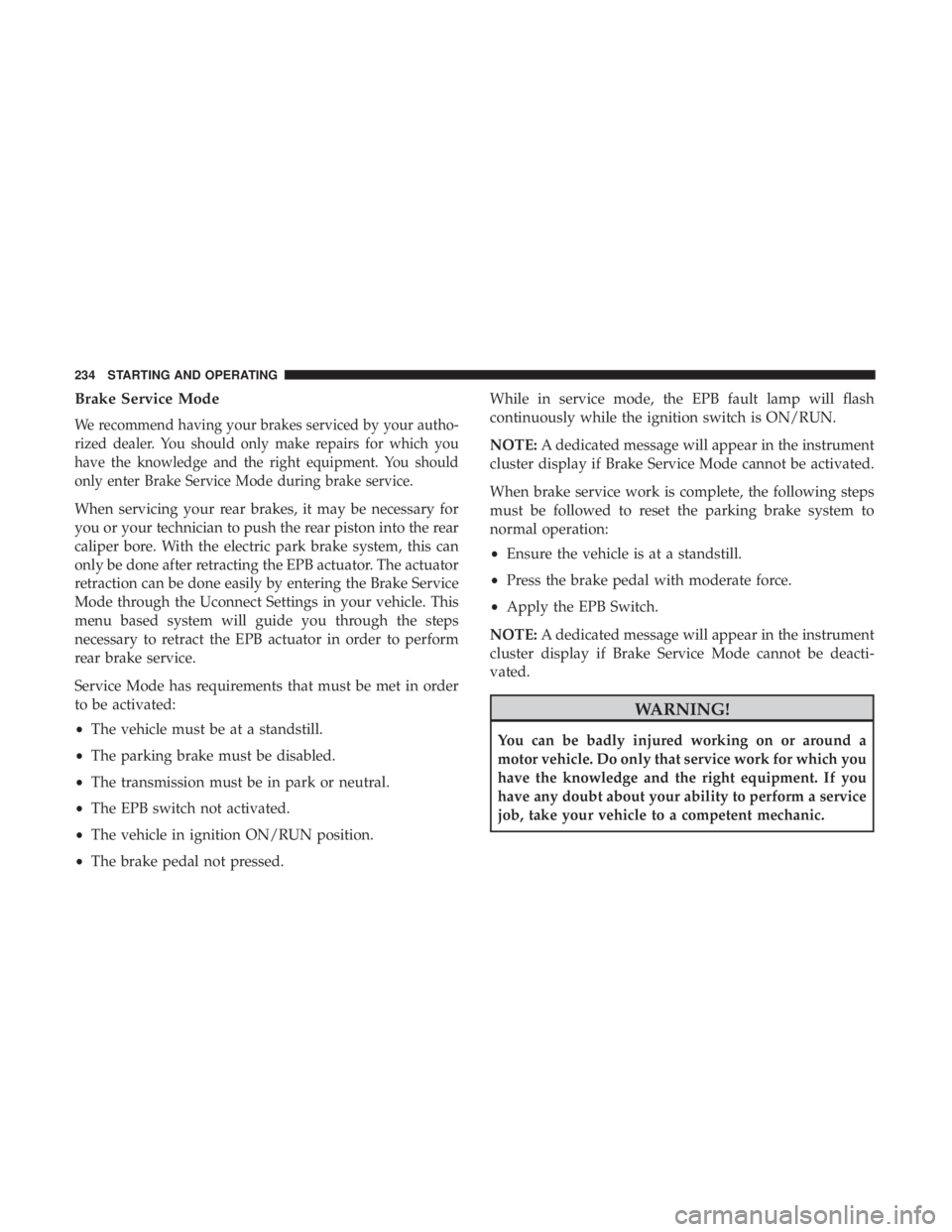
Brake Service Mode
We recommend having your brakes serviced by your autho-
rized dealer. You should only make repairs for which you
have the knowledge and the right equipment. You should
only enter Brake Service Mode during brake service.
When servicing your rear brakes, it may be necessary for
you or your technician to push the rear piston into the rear
caliper bore. With the electric park brake system, this can
only be done after retracting the EPB actuator. The actuator
retraction can be done easily by entering the Brake Service
Mode through the Uconnect Settings in your vehicle. This
menu based system will guide you through the steps
necessary to retract the EPB actuator in order to perform
rear brake service.
Service Mode has requirements that must be met in order
to be activated:
•The vehicle must be at a standstill.
• The parking brake must be disabled.
• The transmission must be in park or neutral.
• The EPB switch not activated.
• The vehicle in ignition ON/RUN position.
• The brake pedal not pressed. While in service mode, the EPB fault lamp will flash
continuously while the ignition switch is ON/RUN.
NOTE:
A dedicated message will appear in the instrument
cluster display if Brake Service Mode cannot be activated.
When brake service work is complete, the following steps
must be followed to reset the parking brake system to
normal operation:
• Ensure the vehicle is at a standstill.
• Press the brake pedal with moderate force.
• Apply the EPB Switch.
NOTE: A dedicated message will appear in the instrument
cluster display if Brake Service Mode cannot be deacti-
vated.
Page 237 of 518
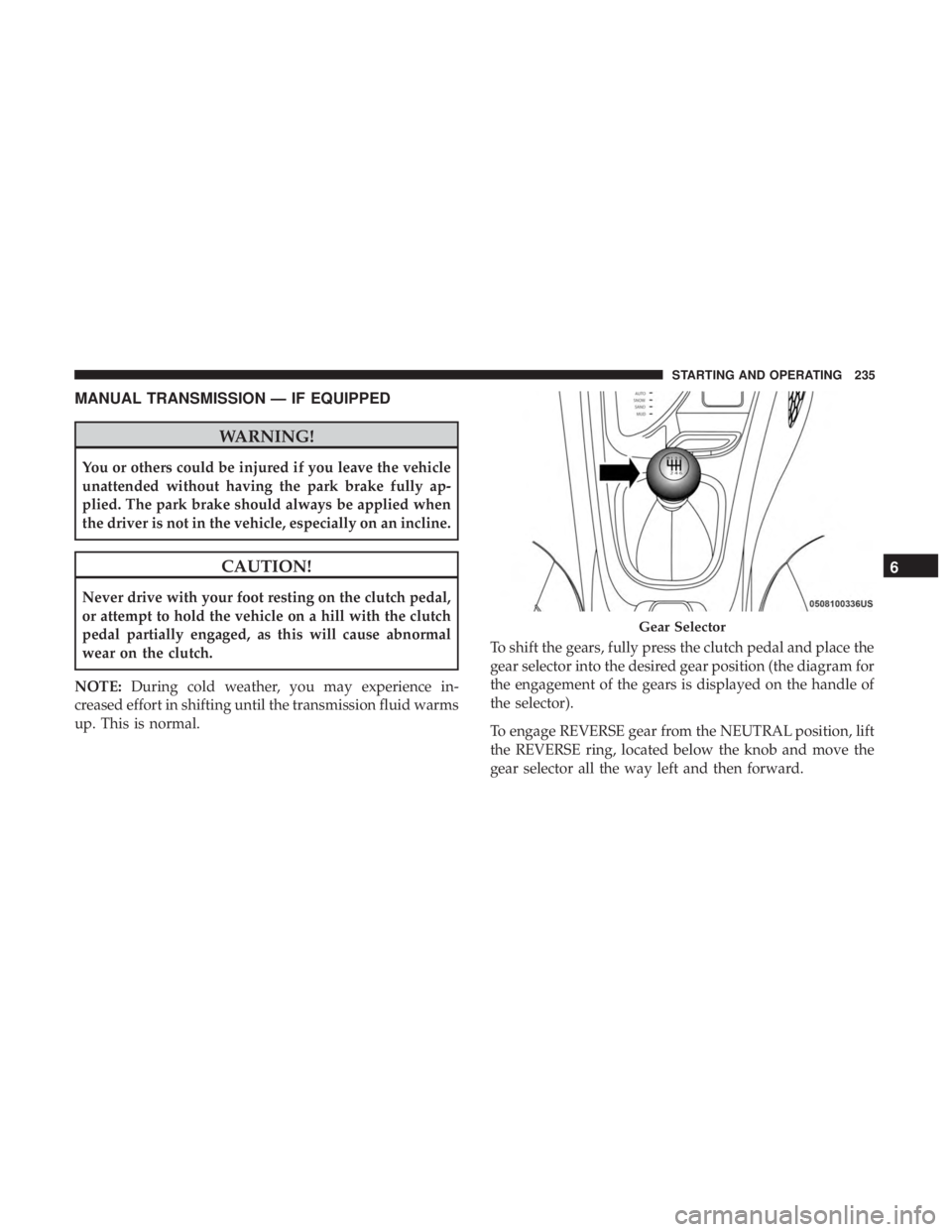
MANUAL TRANSMISSION — IF EQUIPPED
Page 239 of 518
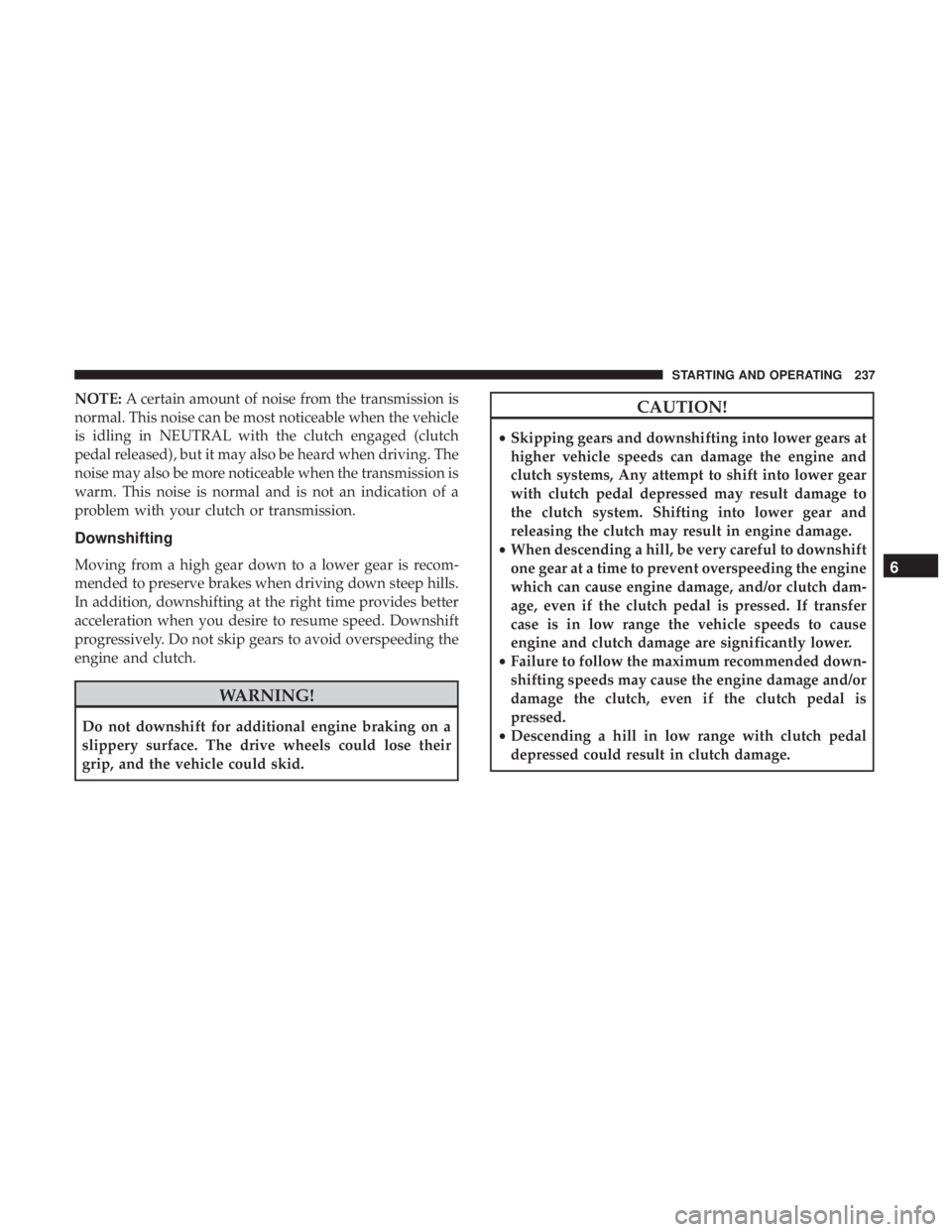
NOTE:A certain amount of noise from the transmission is
normal. This noise can be most noticeable when the vehicle
is idling in NEUTRAL with the clutch engaged (clutch
pedal released), but it may also be heard when driving. The
noise may also be more noticeable when the transmission is
warm. This noise is normal and is not an indication of a
problem with your clutch or transmission.
Downshifting
Moving from a high gear down to a lower gear is recom-
mended to preserve brakes when driving down steep hills.
In addition, downshifting at the right time provides better
acceleration when you desire to resume speed. Downshift
progressively. Do not skip gears to avoid overspeeding the
engine and clutch.
Page 241 of 518
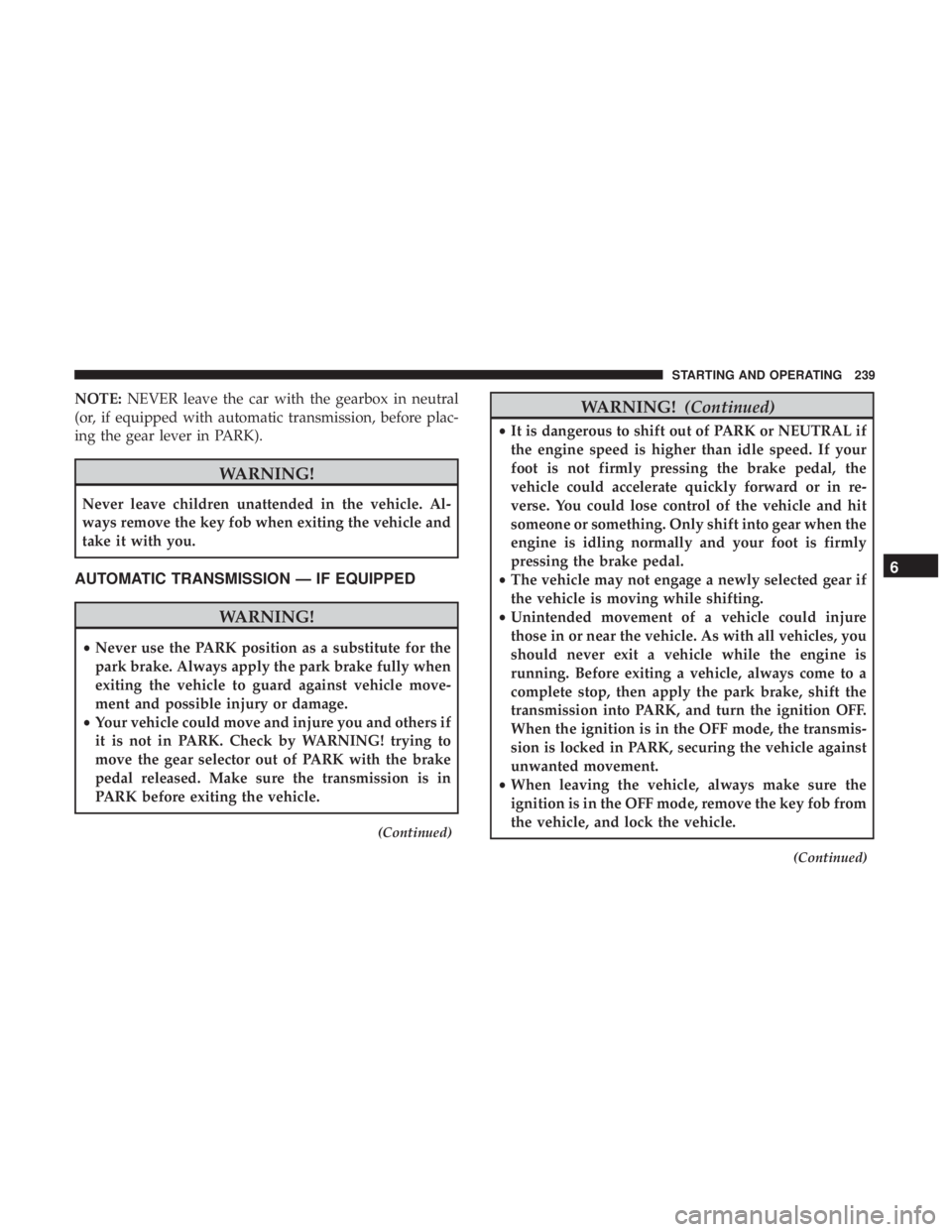
NOTE:NEVER leave the car with the gearbox in neutral
(or, if equipped with automatic transmission, before plac-
ing the gear lever in PARK).
Page 254 of 518
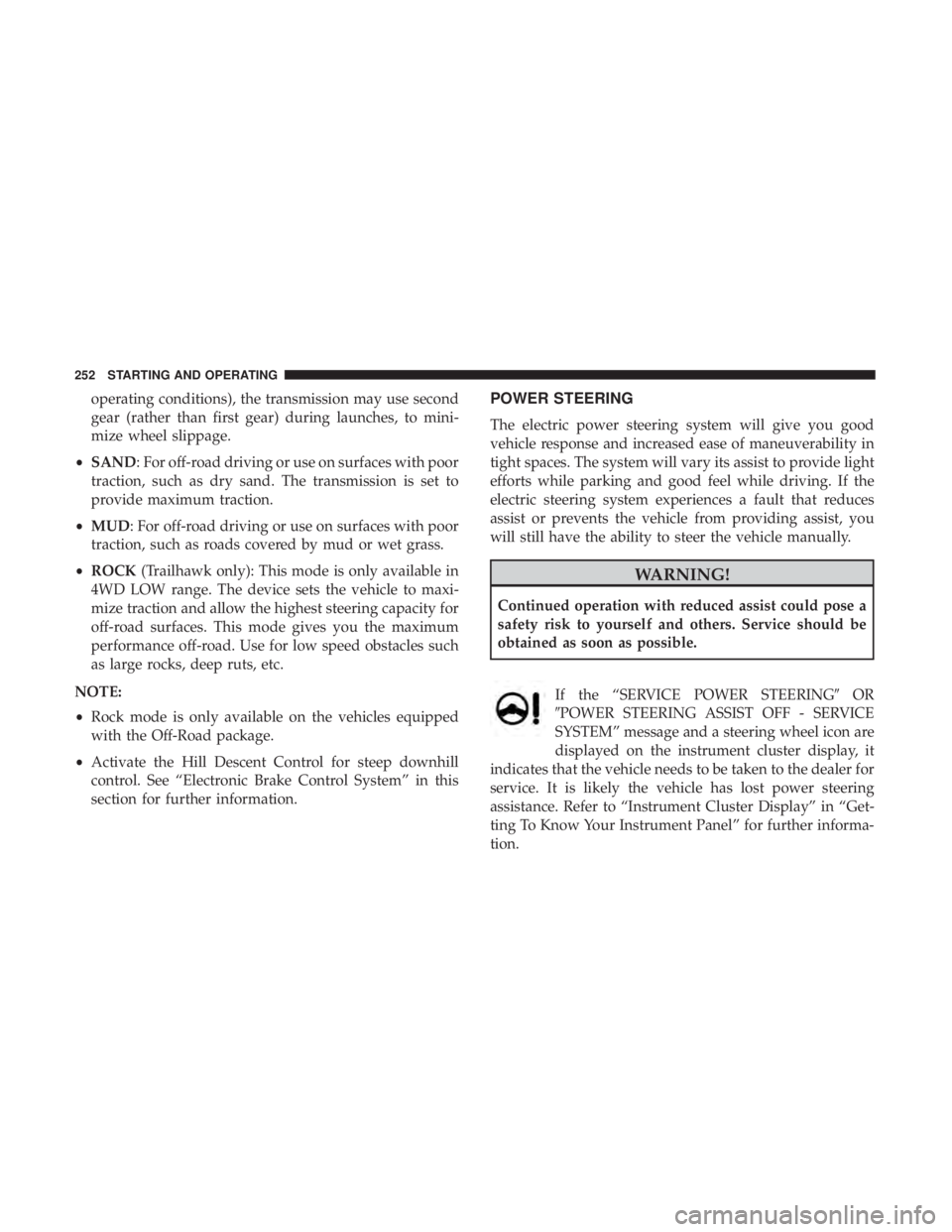
operating conditions), the transmission may use second
gear (rather than first gear) during launches, to mini-
mize wheel slippage.
• SAND: For off-road driving or use on surfaces with poor
traction, such as dry sand. The transmission is set to
provide maximum traction.
• MUD: For off-road driving or use on surfaces with poor
traction, such as roads covered by mud or wet grass.
• ROCK (Trailhawk only): This mode is only available in
4WD LOW range. The device sets the vehicle to maxi-
mize traction and allow the highest steering capacity for
off-road surfaces. This mode gives you the maximum
performance off-road. Use for low speed obstacles such
as large rocks, deep ruts, etc.
NOTE:
• Rock mode is only available on the vehicles equipped
with the Off-Road package.
• Activate the Hill Descent Control for steep downhill
control. See “Electronic Brake Control System” in this
section for further information.POWER STEERING
The electric power steering system will give you good
vehicle response and increased ease of maneuverability in
tight spaces. The system will vary its assist to provide light
efforts while parking and good feel while driving. If the
electric steering system experiences a fault that reduces
assist or prevents the vehicle from providing assist, you
will still have the ability to steer the vehicle manually.
Page 284 of 518
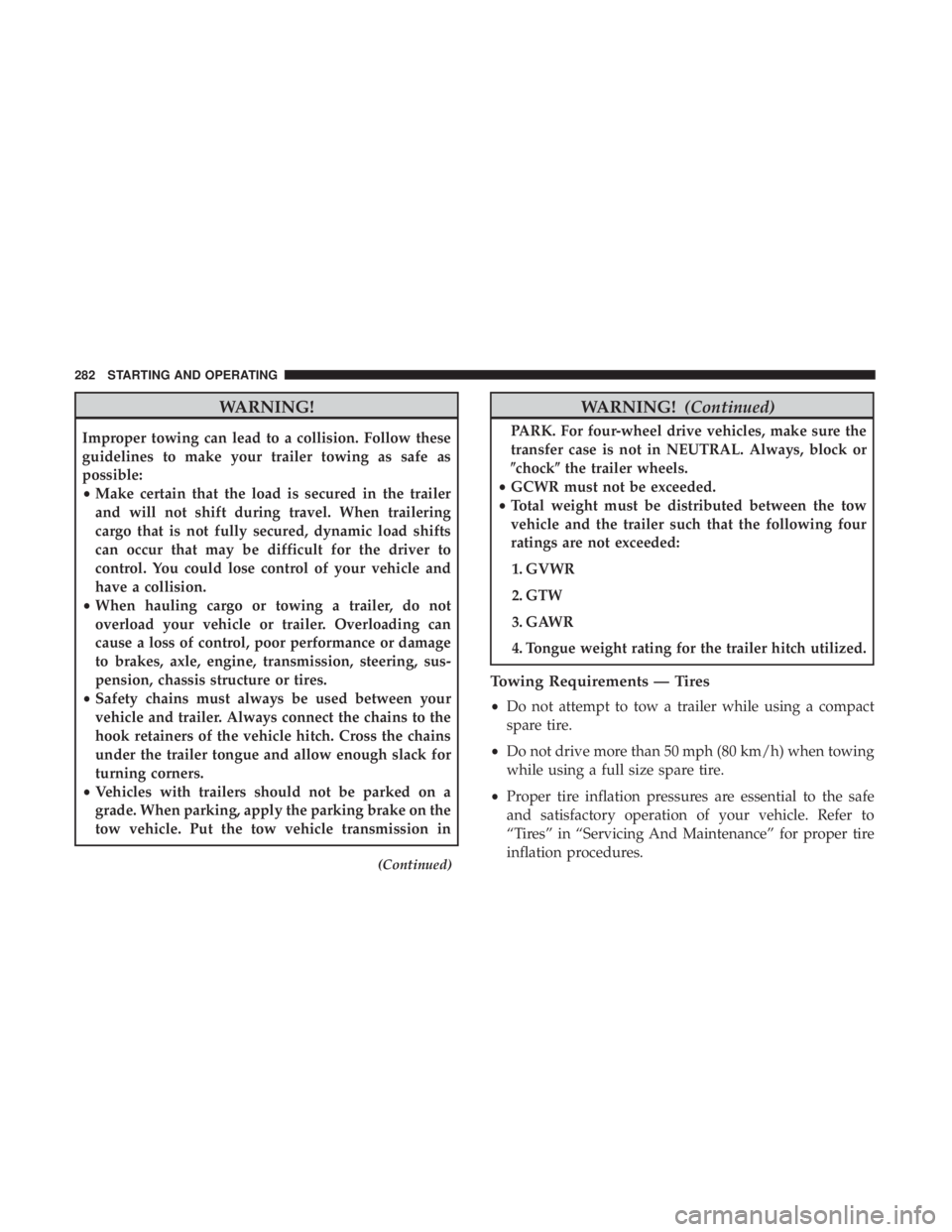
WARNING!
Improper towing can lead to a collision. Follow these
guidelines to make your trailer towing as safe as
possible:
•Make certain that the load is secured in the trailer
and will not shift during travel. When trailering
cargo that is not fully secured, dynamic load shifts
can occur that may be difficult for the driver to
control. You could lose control of your vehicle and
have a collision.
• When hauling cargo or towing a trailer, do not
overload your vehicle or trailer. Overloading can
cause a loss of control, poor performance or damage
to brakes, axle, engine, transmission, steering, sus-
pension, chassis structure or tires.
• Safety chains must always be used between your
vehicle and trailer. Always connect the chains to the
hook retainers of the vehicle hitch. Cross the chains
under the trailer tongue and allow enough slack for
turning corners.
• Vehicles with trailers should not be parked on a
grade. When parking, apply the parking brake on the
tow vehicle. Put the tow vehicle transmission in
(Continued)